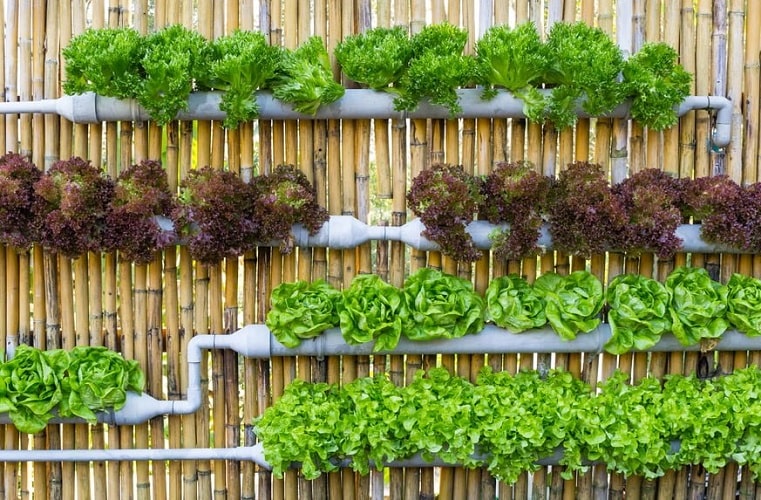Home gardeners sometimes neglect to make use of the space created by vertical areas in their yards. If you’re creative, you can use vertical spaces to produce some unusual and beautiful effects in your garden. Vertical gardening is also appealing if you have a small yard or apartment with limited places to grow plants. You’ll learn how to make the best use of the vertical space you have to create a functional and attractive garden.
Vertical Gardening Tips
Location is an important part of vertical gardening. Make sure you place garden arbors and other structures where they won’t shade out other plants. You’ll also want to ensure that the plants you grow on your trellises or garden arbors will get enough sunlight. Orient the structure accordingly. Moreover, if you have seasonal winds, you may want to locate your arbor or trellis in a safe place where your plants are less likely to blow off.
If you have vines growing in your garden, you’ll need to keep the base of the plant mulched with about four inches of organic mulch. This will ensure that your soil retains water during the warmer weeks of the summer. The mulch will also add nutrients to the soil. Some vines and other vertically growing plants dry out quickly, so make sure and water them frequently.
When you grow plants vertically, you’ll want to keep constant tabs on them so they don’t grow where you don’t want them to go. Some vines can quickly attach themselves to rain gutters and pull them away from the wall if you’re not careful! Also, when planning your vertical garden, make sure you think about access for maintenance. Will you need a ladder to prune your vines, or can you reach them easily?
As your plants grow up your trellis, wall, or garden arbor, you may need to keep them fastened to the structure and train them so they won’t slump off or fall. Some vines will attach more readily to a surface and wind in and out of a trellis or arbor, but others need a helping hand now and then. Twine is a good choice for tying your plants, and won’t damage the stems. You can typically find weatherproof garden twine at your local garden supply store.
Read More: Tips And Tricks To Help You Grow Your Plants Big And Strong
Benefits of Vertical Gardening
In addition to allowing gardeners with limited space to grow a variety of plants, vertical gardening has many other benefits. Growing plants on trellises and garden arbors can help add shade to your yard to help cool off your landscaping and your home.
If you have a view you’d like to block or an unattractive structure you’d like to cover, you can use vines and other plants to help disguise these unappealing landscape features. If you grow plants over walls, fences, and trellises, vertical gardening can also add more privacy to your home.
In many cases, vertical gardening will allow you to work standing up, so you can save your back a lot of wear and tear. Hanging baskets and grow bags are a great way to grow both flowers and vegetables in a small vertical space. These items are very popular with older gardeners who don’t want to stoop to work on their plants.
Additionally, growing plants in this manner means that they generally have fewer problems with pests and diseases, as many pests can’t even reach your plants! Additionally, keeping your tomatoes off the ground with a Topsy Turvy planter will keep them free of soil-borne diseases.
Read More: How To Turn A Small Space Into A Big Harvest With Vertical Garden
Growing Fruits and Vegetables Vertically
Tomatoes are ideal to grow vertically as they are plants that get rather unwieldy if left to grow on the ground. Thus, they grow best when trained to grow in a tomato cage, or on some sort of support structure. When you grow tomatoes vertically, they take up less space and are less susceptible to soil-borne diseases. Remember, tomatoes also grow great in this Topsy Turvy planter.
Some varieties of cucumbers work well as vertical plants. Cucumbers that have a tendency to climb and grow as vines work well on trellises or other gardening structures.
Corn is a vegetable that needs abundant vertical space to grow well. Moreover, you can actually use your stalks of corn to grow other vertically oriented vegetables, especially beans. Beans also fix nitrogen in the soil, so if you plant them along with your corn, all the plants in your garden will benefit.
Beans grow as both bushes or as vertically climbing plants. Pole beans can climb quite tall and in some cases may need a large structure to grow on. Try them out on one of these beautiful garden trellises.
There are a number of fruits that you can grow in your vertical garden as well. Small melons and passion fruit are examples of fruits you can grow on vertical structures such as trellises. Of course, grapevines make a great plant to grow vertically on garden arbors, fences, or trellises.
Vines and Other Climbing Plants
Vines are an obvious choice for growing on fences, garden arbors, and trellises. Vines can be attractive for both their foliage and their flowers. Wisteria and Trumpet Creeper are popular vines that have beautiful flowers and fill out with lush, green leaves. Vines are also a perfect pick if you want to cover unattractive features in your landscaping, such as utility boxes or old garden sheds.
Note that vines have different ways of growing on vertical surfaces. Some vines, such as grapes, have small, tender structures that wind their way around trellises, garden arbors, fences, etc. Ivy has tiny root-like structures that attach to a range of surfaces. Other vines have structures that are like small suckers that clamp on to vertical surfaces.
You can choose either perennial or annual vines for your landscaping. Annuals such as nasturtium, morning glories, and sweet peas will grow quickly in a single growing season and then die off. This is a good option if you want quick growth and you don’t want a leafless set of branches in your landscaping during the winter.
Popular perennial vines include ivy, clematis, bougainvillea, climbing roses, jasmine, and honeysuckle. Perennial vines will twine, grasp, or lean, depending on the species you pick. Perennial vines can also be evergreen or deciduous. Deciduous vines will lose their leaves in the winter and can often create interest with their twisting, sculptural shapes. Wisteria is a good example. Evergreen vines, such as English ivy, will help keep your landscape green all year round.
Below, you’ll find a list of some recommended vines that you can grow on vertical structures. Most of these plants will look great when growing on an attractive vinyl garden arbor.
| Kind of Plant | Popular Name | Uses | Other Features |
| Annual Vines | Nasturtium | It can grow as a bush or vine. | Edible leaves and flowers. Multi-colored flowers. |
| Morning Glory | Arbors, trellises, etc. It can also be used as a ground cover. | Blooms in the early morning. | |
| Sweet Peas | Trellises and arbors. | Smaller vine. Fragrant blossom. | |
| Black-Eyed Susan (Vine) | Containers and planter boxes. | Non-invasive. Grows to about 12 feet tall. | |
| Moonflower | Most garden structures. | Night bloomer. Grows fast. | |
| Cardinal Climber | Most garden structures. | Attracts hummingbirds. | |
| Perennial Vines | English Ivy | Walls and fences. | Semi-evergreen. She likes the shade. |
| Boston Ivy | Walls and fences. | Grows equally well in sun and shade. It can work as a groundcover. | |
| Clematis | Most garden structures. | Likes sun to partial shade. | |
| Bougainvillea | Fences, arbors, walls, etc. | Won’t grow in colder climates. | |
| Jasmine | Fences, arbors, walls, etc. | Beautiful flowers with a strong scent. | |
| Honeysuckle | Fences, walls, and most garden structures. | Attracts hummingbirds. | |
| Wisteria | Trellises and garden arbors. It can also grow as a stand-alone plant. | She likes full sun. Grape-like clusters of lavender flowers. | |
| Trumpet Creeper | Fences and most gardening structures. Good hummingbird plant. | It can become invasive in some areas. | |
| Climbing Hydrangea | Trees and most garden structures. | White flowers. Grows slowly. | |
| Virginia Creeper | Trees, walls, fences, and most garden structures. | Grows well in both sun and shade. Nice fall color on the leaves. | |
Check out the University of Connecticut Plant Database for tons of info on vines and other plants for the garden. Remember to ask the staff of your local nursery or your local extension agent for more information on vines appropriate for vertical gardening.
Mountaineering Roses
Climbing roses are a popular plant for vertical gardens. Interestingly, botanists do not consider them true climbing plants like vines because they don’t grow their own support structures to hold onto a surface. Therefore, they need a helping hand and a vertical space to attach to and grow on.
If you’re interested in growing roses, you can choose to purchase a trellis or an arbor so that they have a suitable place to grow. You can also be creative and train your roses over a fence, a pillar, a garden shed, or other structures in your yard.
Professional gardeners often refer to roses as pillars, ramblers, trailing roses, and everblooming roses, depending on how they grow. You can find varieties of climbing roses that bloom during the entire growing season (everbloomers), or that only bloom only during the spring (spring bloomers). We can further categorize climbing roses in the following ways:
- Grandifloras
- Floribundas
- Polyanthas
- Hybrid Teas
- Tea Roses
Please see this site from the Kansas State University Extension Service for more information on how gardeners categorize roses.
When you’re getting ready to plant your climbing roses, you’ll need to take into account the following factors:
- The size of your yard or garden.
- The soil and sunlight requirements of the plant.
- The kind of gardening structure you’d like to grow your climbing roses on.
- The height and size of the plant.
- The frequency and color of the blooms.
Be realistic about the space you have to grow your climbing roses. Although you may want a sprawling 30-foot batch of rose blossoms, if you have a smaller yard you may have to grow a more humble plant.
Always take into account the quality of the soil and the amount of sunlight your roses need to grow. You can amend your soil with high-quality compost to improve drainage and give your roses the proper nutrients they need to grow. Roses also appreciate a dose of organic rose fertilizer now and again.
Most roses like sunny, warm conditions. However, if you don’t have an appropriate place in your garden that will get 6-7 hours of sunlight a day, there are a few varieties of climbing roses that will grow in partial shade. Hybrid musk roses are good choices for growing in partial shade.
Climbing roses are appropriate for growing on a number of garden structures. While arbors and trellises are popular for growing roses, you can also check out pergolas and tripods. As we mentioned above, you can also be creative and grow your roses on fences, garden sheds, pillars, and a variety of other structures in your yard or garden.
mountaineering roses vary in how tall and ample they will grow. They can get up to 30 feet tall like the Climbing Cecile Brunner, or be a more humble 7 feet tall like the Westerland rose. Talk to your local nursery or extension agent about the climbing roses that are appropriate for your yard. And remember to be realistic about the time you have for gardening and pruning. Also, make sure you always pick a rose that is appropriate for the garden structure you’d like to grow it on.
If you’ve just planted your climbing rose, be patient, as they may take a while to get established and start blooming. Also, take into account that roses can vary in height depending on the local climate. Your nursery or extension agent should have a good idea of what to expect when you plant a certain variety of roses.
Like all roses, there are dozens of colors of roses you can choose from. Another important factor to consider is how often they will bloom. As we mentioned above, climbing roses will either bloom once during the spring or during the entire growing season. We call these roses “spring bloomers” and “everbloomers.” See our list of roses below for more information. Try out a rose on a metal garden arbor.
Recommended Varieties of Roses
| Name | Growing Height | Color | Other Features |
| ALCHYMIST | 13 feet | Orange | Once blooming. |
| ALOHA | 9 feet | Pink | Blooms all growing season. Disease resistant. |
| AMERICA | 13 feet | Pink-Orange | Disease resistant, everblooming. |
| BUBBLE BATH | 10 feet | Pink. | Hybrid Musk. |
| CLIMBING CECILE BRUNNER | 30 feet | Pink | Huge climber. Blooms once. Needs lots of room. |
| COMPASSION | 10 feet | Orange to pink | The most popular climbing rose in England. |
| “DARLOW’S ENIGMA” | 8 feet as a shrub, more if grown as a rambling rose | White | Rambling rose. Disease resistant. Everblooming. |
| DON JUAN | 10 feet | Red | Climbs well on pillars. Continuous blooms. |
| EDEN | 10 feet | Pink | Works well on a variety of structures. |
| HANDEL | 12 feet | Pink with white highlights | Blooms throughout the growing season. |
| NEW DAWN | 20 feet | Pink | Very popular climbing rose. Always blooms. |
| PORTLANDIA | 10 feet | Creamy pink | Disease-resistant with continuous blooms. |
| RED EDEN | 10 feet | Red | Large blooms. |
| SUMMER WINE | 13 feet | Lightly wine colored | Single blooms on a cluster. |
| WESTERLAND | 6-7 feet | Orange | A good rose for small spaces. Winter hardy. |
| WHITECAP | 10 feet | White | Winter hardy. Repeat blooming. |
| ZÉPHIRINE DROUHIN | 12 feet | Pink | Thornless rose. Blooms throughout the growing season. |
Remember, climbing roses look great when displayed on one of these attractive wooden garden arbors.
Other Vertical Gardening Structures
Old wooden ladders, poles, antique wooden wheelbarrows, and even old cars can be attractive features where you can grow plants vertically. Other simple structures for vertical gardening include pergolas. Additionally, you can use raised beds, planter boxes, and containers for your vertical garden.
Raised Beds and Planter Boxes
Window boxes are a good option for growing indoors or on your window sill. There are many styles available. They typically are made of wood, plastic, or fired clay.
When using window boxes, you should fill them with high-quality potting soil. This soil is designed for containers and will drain well. You may need to line the window box to keep the soil from leaking out. Just make sure that the liner has a few small holes punched in it to let the water drain.
You may also design a raised bed garden to grow a variety of plants if you don’t have a garden plot. Raised beds work great on patios and decks. A benefit of working with raised beds is that you can personalize the height of the bed. This will allow you to work standing or sitting. You can also make your own soil mixture when setting up your beds. Please see the Raised Bed Gardening Guide for more information.
Planter boxes are similar to raised beds and are typically small containers that are designed to grow many different kinds of plants.
Containers
Containers are another great option for growing plants vertically. You can buy containers and hang them from a variety of hooks or poles.
There are also a number of unusual containers specifically designed for growing large quantities of crops in vertical spaces. The Topsy Turvy gardening system is a great way to grow tomatoes, flowers, and other plants in a small vertical space. Vertical grow bags are another option.
Traditional containers are available in many styles. You can choose to use wire or wood baskets, plastic pots, clay containers, etc. Wire and wood baskets are also suitable for hanging on stands, arbors, hooks, and many other surfaces.
Wherever you hang them, just make sure you have some way to catch the excess water from the plants so the water doesn’t drip and ruin your favorite table. Also, check the weight of the plant and be sure that the structure you hang your container on can handle the weight. You may also consider the addition of a special polymer to the soil that will help the soil retain water.
If you want to try something unusual, try out this vertical hydroponic garden system. You can grow tomatoes or other veggies without soil in this container.
Vertical Garden Equipment
If you don’t have any walls or fences in your home to grow your plants, your best bet is to look into buying a trellis or a garden arbor.
These outdoor structures are perfect for growing flowering vines, climbing roses, and even some climbing vegetables, such as peas.
Garden Arbors
Arbors are typically made from vinyl, iron other metals, or wood. Arbors can even have a small bench or swing built into the structure, making them ideal for relaxing.
The addition of a vine growing up and over your arbor will make it a cool and shady spot. Garden arbors come in a wide variety of styles. You can purchase arbors with flat roofs, arched roofs, or gabled roofs. Some garden arbors even come with gates or planters, making them functional pieces of art.
Trellises
Trellises are leaning or stand-alone structures that will work for a variety of plants. Both flowering vines and some vegetables work well when grown on trellises. Trellises are also useful for creating privacy barriers and “walls” where none exist in your yard.












